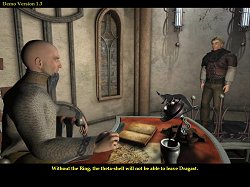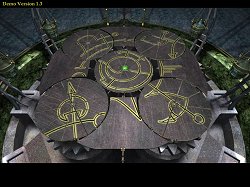|
Aura: The Fate of the Ages
 Aura: The Fate of the Ages promises four intriguing worlds to explore: "The Ademika Valley - gateway and the world of secret research and sacred rituals, Dragast - the mechanical world and the kingdom of mountains and snow, Na-Tiexu - the esoteric world of astronomy and magic, and lastly, the beautiful Island of Unity."
The generous demo I played was actually the beta preview build of the mountainous mechanical realm of Dragast. As such it gave a real 'hands on' feel to how the full game will play and I spent about four hours exploring and solving various puzzles. The introduction to this level opens with sumptuous scenes of a strange flying machine soaring into the snow covered mountains bearing Umang, your character, towards exotic structures linked by metallic bridges.
Umang is a student who was sent initially to Ademika to complete his training with Grifit, the old master. But he has learned of a plot to steal the sacred rings which, if the legends are to be believed, can enable one to travel to, and create new worlds, and may even confer immortality and power. This I learned from the written material provided with the demo and clearly it will be fleshed out more in the actual game. It gave me just enough of an overview to provide a context for what I experienced at Dragast. Aura: The Fate of the Ages promises four intriguing worlds to explore: "The Ademika Valley - gateway and the world of secret research and sacred rituals, Dragast - the mechanical world and the kingdom of mountains and snow, Na-Tiexu - the esoteric world of astronomy and magic, and lastly, the beautiful Island of Unity."
The generous demo I played was actually the beta preview build of the mountainous mechanical realm of Dragast. As such it gave a real 'hands on' feel to how the full game will play and I spent about four hours exploring and solving various puzzles. The introduction to this level opens with sumptuous scenes of a strange flying machine soaring into the snow covered mountains bearing Umang, your character, towards exotic structures linked by metallic bridges.
Umang is a student who was sent initially to Ademika to complete his training with Grifit, the old master. But he has learned of a plot to steal the sacred rings which, if the legends are to be believed, can enable one to travel to, and create new worlds, and may even confer immortality and power. This I learned from the written material provided with the demo and clearly it will be fleshed out more in the actual game. It gave me just enough of an overview to provide a context for what I experienced at Dragast.
Choosing to use Dragast as the preview demo will invite the inevitable comparisons with Myst. The impressive settings, first person perspective, and the logical mechanical puzzles where you must experiment with mysterious devices to see what the effect will be of pushing buttons, pulling levers or twirling cylinders marked with strange symbols. On that level Aura stands up well in the comparison. But on another level Aura moves beyond Myst and provides integrated interaction with other characters, and conversations take place in third person cut scenes so you can see Umang ask his questions (and you do have the option to enable subtitles). It also provides an inventory so you can collect items to use in the game world and there is a book that highlights when you learn a clue and a new page appears with sketches of devices or symbols to point you in the right direction without necessarily solving the puzzle for you.
 The animations are well integrated and the music is relaxing and encourages peaceful exploration though the backgrounds are a little static. The wind moans through the mountains but a little cloud movement would have completed the picture. The characters too have only sparse lip movement when they speak, but these are only minor issues. I was caught up for a while on one occasion, however, after speaking to a mechanic at a distance. He told me to take a broken battery to the blacksmith to be repaired so I spent some time looking around for it only to eventually find that it had magically appeared in my inventory. I didn't detect any indication that the mechanic had given it to me. Perhaps if the new item had highlighted like the book does this would have alerted me to check my inventory.
Like many first person perspective games movement is from node to node and you can pan around vertically and horizontally. The puzzles are challenging and on the whole fair though you will need to experiment with many of them to learn the logic behind them. Solving a puzzle may get a machine working or open a door or perhaps give access to a secret location. One aspect I particularly liked was if you solve a puzzle that causes something to happen in another location you get a little cut scene showing the effect so that you know that you have been successful.
I quite enjoyed my time in Dragast and I am looking forward to playing the full game and experiencing some of the more esoteric worlds. It will be interesting to see if the style of puzzles vary in the different locations. The animations are well integrated and the music is relaxing and encourages peaceful exploration though the backgrounds are a little static. The wind moans through the mountains but a little cloud movement would have completed the picture. The characters too have only sparse lip movement when they speak, but these are only minor issues. I was caught up for a while on one occasion, however, after speaking to a mechanic at a distance. He told me to take a broken battery to the blacksmith to be repaired so I spent some time looking around for it only to eventually find that it had magically appeared in my inventory. I didn't detect any indication that the mechanic had given it to me. Perhaps if the new item had highlighted like the book does this would have alerted me to check my inventory.
Like many first person perspective games movement is from node to node and you can pan around vertically and horizontally. The puzzles are challenging and on the whole fair though you will need to experiment with many of them to learn the logic behind them. Solving a puzzle may get a machine working or open a door or perhaps give access to a secret location. One aspect I particularly liked was if you solve a puzzle that causes something to happen in another location you get a little cut scene showing the effect so that you know that you have been successful.
I quite enjoyed my time in Dragast and I am looking forward to playing the full game and experiencing some of the more esoteric worlds. It will be interesting to see if the style of puzzles vary in the different locations.
Copyright © Gordon Aplin 2004.
All rights reserved.
System Requirements:
Windows 98SE/ME/2000/XP, 800 MHz Pentium III (or Equivalent) RAM: 64 MB (128MB Recommended) 16x CD-ROM Drive (24x CD_ROM Drive Recommended) 1.3 GB Hard Disk Space ( 2.4GB Recommended) 32MB DirectX 8/9 Compatible 3D Video Card (or Higher) DirectSound Compatible DirectX 8.1 (or Higher)
|
